Heat Transfer Characteristics of an Electric Motor with Oil-Dripping Cooling under Overload Conditions
Abstract
1. Introduction
2. Experimental Methodology
2.1. Description of Experimental Set-Up
2.2. Experimental Parameters and Uncertainty Analysis
3. Results and Discussion
3.1. Effect of Dripping Hole Diameter at Various Overload Operating Powers
3.1.1. Maximum Temperature
3.1.2. Heat Transfer Coefficient
3.1.3. Power Consumption
3.2. Effect of Oil Flow Rate at Various Overload Operating Powers
3.2.1. Maximum Temperature
3.2.2. Heat Transfer Coefficient
3.2.3. Power Consumption
4. Conclusions
- (a)
- The maximum temperature decreased with an increase in the dripping hole diameter such that the lowest maximum temperature was observed for a dripping hole diameter of 4 mm under all overload operating powers. The lowest maximum temperatures of 31.9 °C, 40.2 °C and 46.3 °C were observed for a dripping hole diameter of 4 mm in the case of overload operating powers of 8.28 kW, 12.05 kW and 14.21 kW, respectively.
- (b)
- Higher values of heat transfer coefficient were found for a dripping hole diameter of 4 mm, and with the increase in the overload operating power, the heat transfer coefficient showed a decrement in its values. The heat transfer coefficients of 7528.61 W/m2-K, 4684.69 W/m2-K and 3866.59 W/m2-K were evaluated for the 4 mm dripping hole diameter at overload operating powers of 8.28 kW, 12.05 kW and 14.21 kW, respectively. The power consumption decreased with an increase in the dripping hole diameter.
- (c)
- The oil flow rates of 12 LPM and 16 LPM depicted a lower maximum temperature and higher heat transfer coefficient. However, the power consumptions reported at corresponding oil flow rates were 18.06 W and 37.75 W.
- (d)
- The combination of a 4 mm dripping hole diameter and a 12 LPM oil flow rate is recommended for oil-dripping cooling systems to achieve enhanced heat transfer characteristics of an electric motor.
Author Contributions
Funding
Data Availability Statement
Conflicts of Interest
References
- Alanazi, F. Electric Vehicles: Benefits, Challenges, and Potential Solutions for Widespread Adaptation. Appl. Sci. 2023, 13, 6016. [Google Scholar] [CrossRef]
- Ramraj, R.; Pashajavid, E.; Alahakoon, S.; Jayasinghe, S. Quality of Service and Associated Communication Infrastructure for Electric Vehicles. Energies 2023, 16, 7170. [Google Scholar] [CrossRef]
- Popescu, M.; Riviere, N.; Volpe, G.; Villani, M.; Fabri, G.; di Leonardo, L. A Copper Rotor Induction Motor Solution for Electrical Vehicles Traction System. In Proceedings of the IEEE Energy Conversion Congress and Exposition (ECCE 2019), Baltimore, MD, USA, 29 September–3 October 2019; pp. 3924–3930. [Google Scholar]
- Lucas, S.; Bari, S.; Marian, R.; Lucas, M.; Chahl, J. Cooling by Peltier effect and active control systems to thermally manage operating temperatures of electrical Machines (Motors and Generators). Therm. Sci. Eng. Prog. 2022, 27, 100990. [Google Scholar] [CrossRef]
- Tola, O.J.; Ambafi, J.G.; Umoh, E.A.; Osinowo, O.E. Performance analysis of a pmsm for traction applications in electric vehicles with hairpin winding technology. In Proceedings of the IEEE Nigeria 4th International Conference on Disruptive Technologies for Sustainable Development (NIGERCON 2022), Lagos, Nigeria, 5–7 April 2022; pp. 1–5. [Google Scholar]
- Ha, T.; Kim, D.K. Study of injection method for maximizing oil-cooling performance of electric vehicle motor with hairpin winding. Energies 2021, 14, 747. [Google Scholar] [CrossRef]
- Wang, X.; Li, B.; Gerada, D.; Huang, K.; Stone, I.; Worrall, S.; Yan, Y. A critical review on thermal management technologies for motors in electric cars. Appl. Therm. Eng. 2022, 201, 117758. [Google Scholar] [CrossRef]
- Momen, F.; Rahman, K.; Son, Y. Electrical propulsion system design of Chevrolet Bolt battery electric vehicle. IEEE Trans. Ind. Appl. 2018, 55, 376–384. [Google Scholar] [CrossRef]
- Yang, Y.; Bilgin, B.; Kasprzak, M.; Nalakath, S.; Sadek, H.; Preindl, M.; Emadi, A. Thermal management of electric machines. IET Electr. Syst. Transp. 2017, 7, 104–116. [Google Scholar] [CrossRef]
- Yang, X.; Fatemi, A.; Nehl, T.; Hao, L.; Zeng, W.; Parrish, S. Comparative study of three stator cooling jackets for electric machine of mild hybrid vehicle. IEEE Trans. Ind. Appl. 2020, 57, 1193–1201. [Google Scholar] [CrossRef]
- Liu, M.; Li, Y.; Ding, H.; Sarlioglu, B. Thermal management and cooling of windings in electrical machines for electric vehicle and traction application. In Proceedings of the IEEE Transportation Electrification Conference and Expo (ITEC 2017), Chicago, IL, USA, 22–24 June 2017; pp. 668–673. [Google Scholar]
- Acquaviva, A.; Skoog, S.; Thiringer, T. Design and verification of in-slot oil-cooled tooth coil winding PM machine for traction application. IEEE Trans. Ind. Electron. 2020, 68, 3719–3727. [Google Scholar] [CrossRef]
- Lindh, P.; Petrov, I.; Jaatinen-Värri, A.; Grönman, A.; Martinez-Iturralde, M.; Satrústegui, M.; Pyrhönen, J. Direct liquid cooling method verified with an axial-flux permanent-magnet traction machine prototype. IEEE Trans. Ind. Electron. 2017, 64, 6086–6095. [Google Scholar] [CrossRef]
- Venturini, G.; Volpe, G.; Villani, M.; Popescu, M. Investigation of cooling solutions for hairpin winding in traction application. In Proceedings of the International Conference on Electrical Machines (ICEM 2020), Gothenburg, Sweden, 23–26 August 2020; Volume 1, pp. 1573–1578. [Google Scholar]
- Venturini, G.; Volpe, G.; Popescu, M. Slot water jacket cooling system for traction electrical machines with hairpin windings: Analysis and comparison. In Proceedings of the IEEE International Electric Machines & Drives Conference (IEMDC 2021), Hartford, CT, USA, 17–20 May 2021; pp. 1–6. [Google Scholar]
- Park, J.; An, J.; Han, K.; Choi, H.S.; Park, I.S. Enhancement of cooling performance in traction motor of electric vehicle using direct slot cooling method. Appl. Therm. Eng. 2022, 217, 119082. [Google Scholar] [CrossRef]
- Huang, Z.; Nategh, S.; Lassila, V.; Alaküla, M.; Yuan, J. Direct oil cooling of traction motors in hybrid drives. In Proceedings of the IEEE International Electric Vehicle Conference (IEVC 2012), Greenville, SC, USA, 4–8 March 2012; pp. 1–8. [Google Scholar]
- Zhang, F.; Gerada, D.; Xu, Z.; Liu, C.; Zhang, H.; Zou, T.; Gerada, C. A thermal modeling approach and experimental validation for an oil spray-cooled hairpin winding machine. IEEE Trans. Transp. Electrif. 2021, 7, 2914–2926. [Google Scholar] [CrossRef]
- Tikadar, A.; Joshi, Y.; Kumar, S. Comparison between Direct Winding Heat Exchanger and Slot-liner Confined Evaporative Cooling of Electric Motor. In Proceedings of the 21st IEEE Intersociety Conference on Thermal and Thermomechanical Phenomena in Electronic Systems (iTherm 2022), San Diego, CA, USA, 31 May–3 June 2022; pp. 1–10. [Google Scholar]
- Davin, T.; Pellé, J.; Harmand, S.; Yu, R. Experimental study of oil cooling systems for electric motors. Appl. Therm. Eng. 2015, 75, 1–13. [Google Scholar] [CrossRef]
- Ponomarev, P.; Polikarpova, M.; Pyrhönen, J. Thermal modeling of directly-oil-cooled permanent magnet synchronous machine. In Proceedings of the International Conference on Electrical Machines (ICEM 2012), Marseille, France, 2–5 September 2012; pp. 1882–1887. [Google Scholar]
- La Rocca, A.; Zou, T.; Moslemin, M.; Gerada, D.; Gerada, C.; Cairns, A. Thermal modelling of a liquid cooled traction machine with 8-layer hairpin windings. In Proceedings of the IECON 2021–47th Annual Conference of the IEEE Industrial Electronics Society, Toronto, ON, Canada, 13–16 October 2021; pp. 1–6. [Google Scholar]
- Guechi, M.R.; Desevaux, P.; Baucour, P.; Espanet, C.; Brunel, R.; Poirot, M. On the improvement of the thermal behavior of electric motors. In Proceedings of the IEEE Energy Conversion Congress and Exposition (ECCE 2013), Denver, CO, USA, 15–19 September 2013; pp. 1512–1517. [Google Scholar]
- Wang, J.X.; Li, Y.Z.; Yu, X.K.; Li, G.C.; Ji, X.Y. Investigation of heat transfer mechanism of low environmental pressure large-space spray cooling for near-space flight systems. Int. J. Heat Mass Transf. 2018, 119, 496–507. [Google Scholar] [CrossRef]
- Available online: https://www.hyundai-lube-me.com/product/xteer-atf-sp4/ (accessed on 17 August 2023).
- Liu, L.; Wang, X.; Ge, M.; Zhao, Y. Experimental study on heat transfer and power consumption of low-pressure spray cooling. Appl. Therm. Eng. 2021, 184, 116253. [Google Scholar] [CrossRef]
- Chong, Y.C.; Goss, J.; Popescu, M.; Staton, D.; Liu, C.; Gerada, D.; Gerada, C. Experimental characterisation of radial oil spray cooling on a stator with hairpin windings. In Proceedings of the 10th International Conference on Power Electronics, Machines and Drives (PEMD 2020), Online, 15–17 December 2020; Volume 2020, pp. 879–884. [Google Scholar]
- Available online: https://www.energy.gov/sites/prod/files/2014/04/f15/10097517.pdf (accessed on 13 November 2023).
- Heat Transfer in Electric Machines. Available online: www.eomys.com (accessed on 9 November 2023).
- Garud, K.S.; Hwang, S.G.; Han, J.W.; Lee, M.Y. Performance characteristics of the direct spray oil cooling system for a driving motor of an electric vehicle. Int. J. Heat Mass Transf. 2022, 196, 123228. [Google Scholar] [CrossRef]
- Garud, K.S.; Seo, J.H.; Bang, Y.M.; Pyo, Y.D.; Cho, C.P.; Lee, M.Y.; Lee, D.Y. Energy, exergy, environmental sustainability and economic analyses for automotive thermoelectric generator system with various configurations. Energy 2022, 244, 122587. [Google Scholar] [CrossRef]
- Seo, J.H.; Garud, K.S.; Lee, M.Y. Grey relational based Taguchi analysis on thermal and electrical performances of thermoelectric generator system with inclined fins hot heat exchanger. Appl. Therm. Eng. 2021, 184, 116279. [Google Scholar] [CrossRef]
- Raj, A.K.; Srinivas, M.; Jayaraj, S. A cost-effective method to improve the performance of solar air heaters using discrete macro-encapsulated PCM capsules for drying applications. Appl. Therm. Eng. 2019, 146, 910–920. [Google Scholar] [CrossRef]
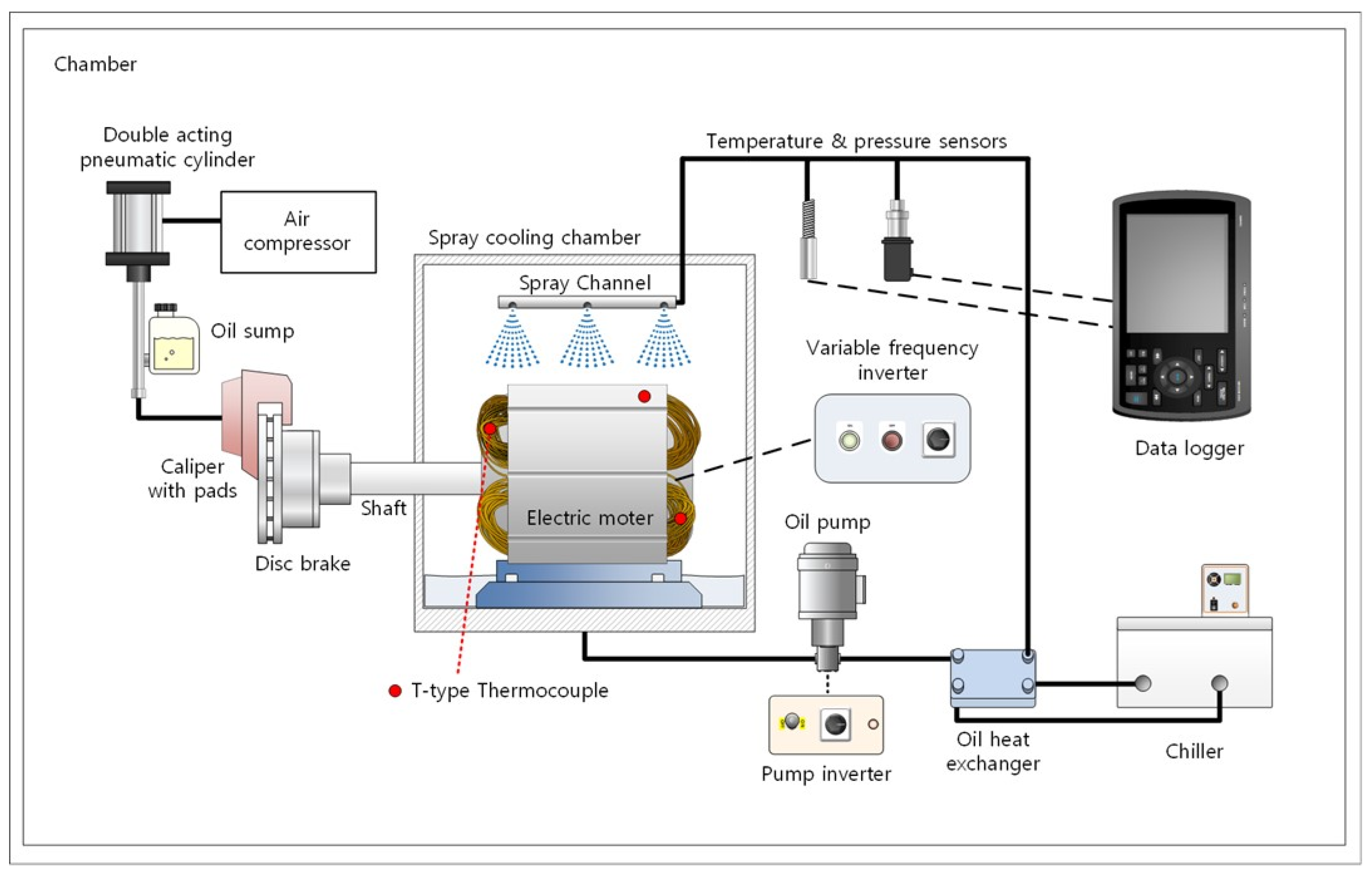

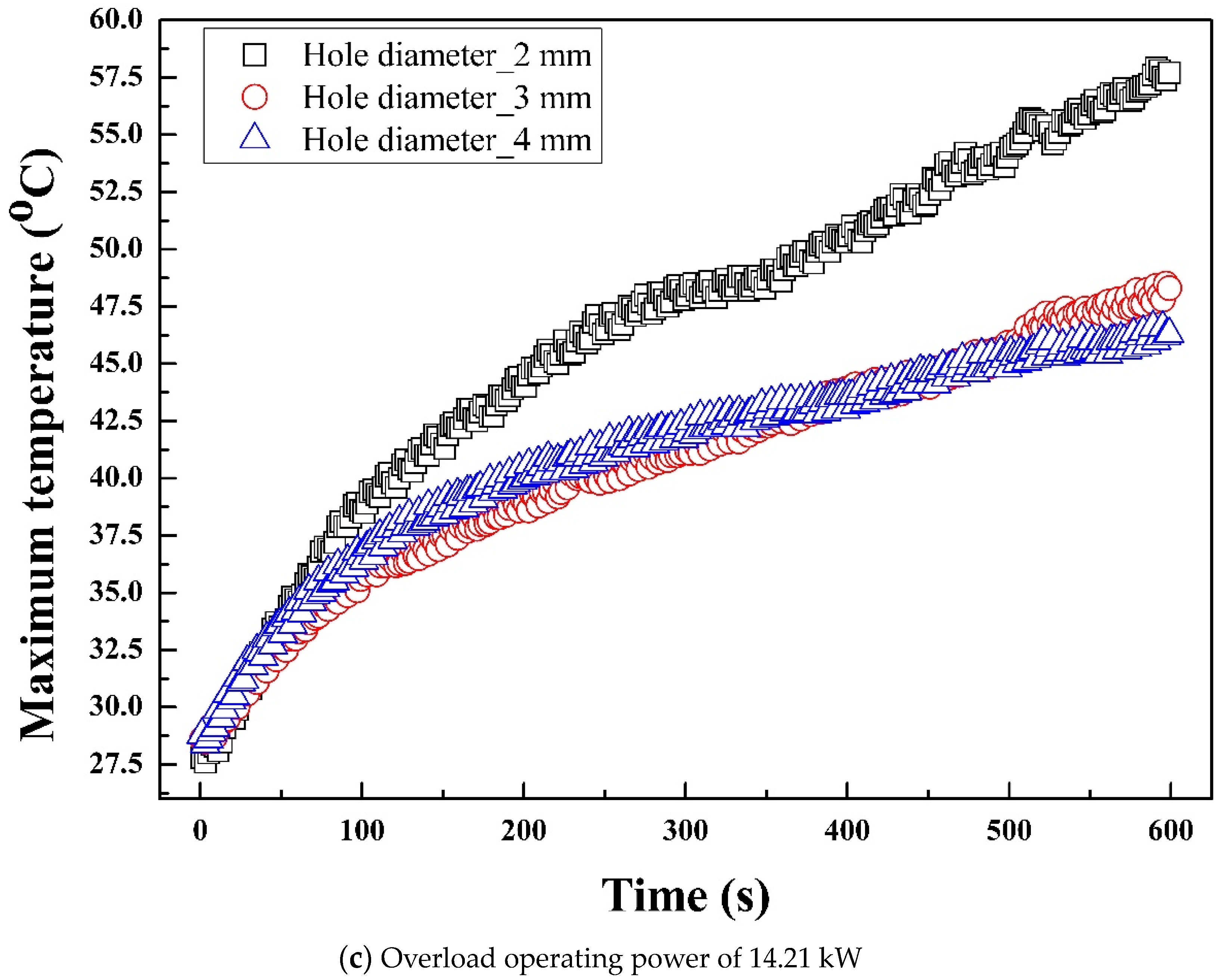




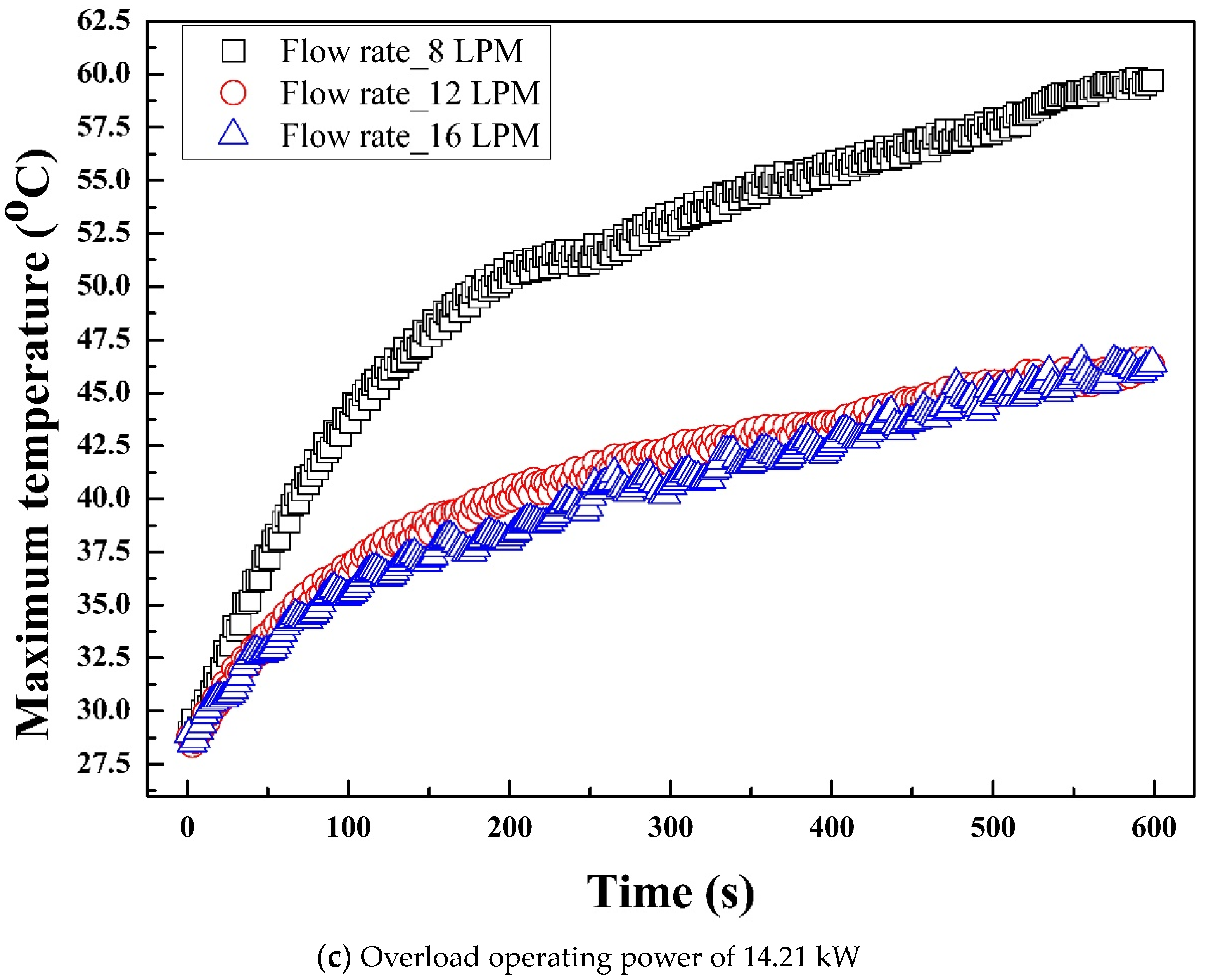
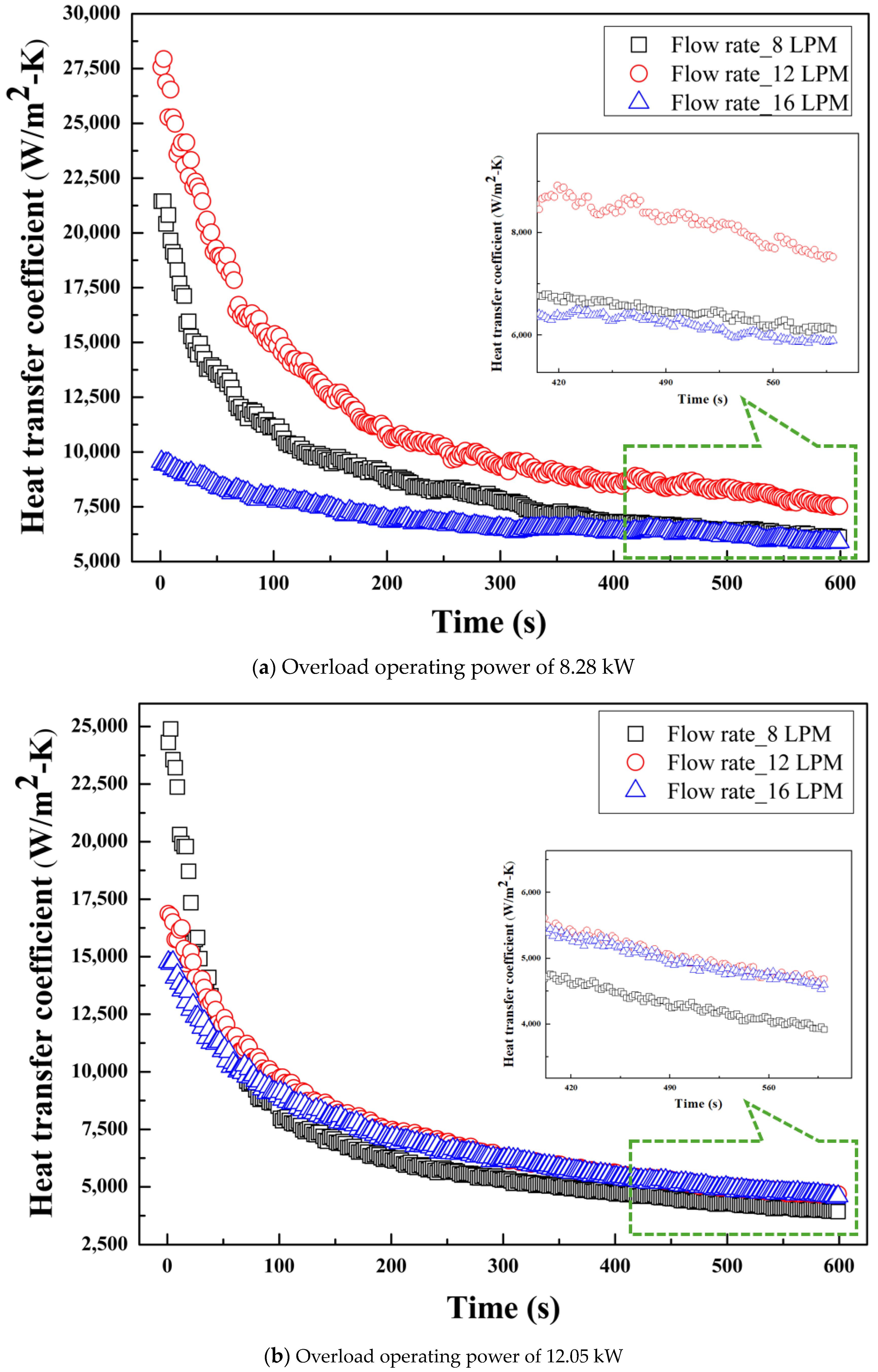
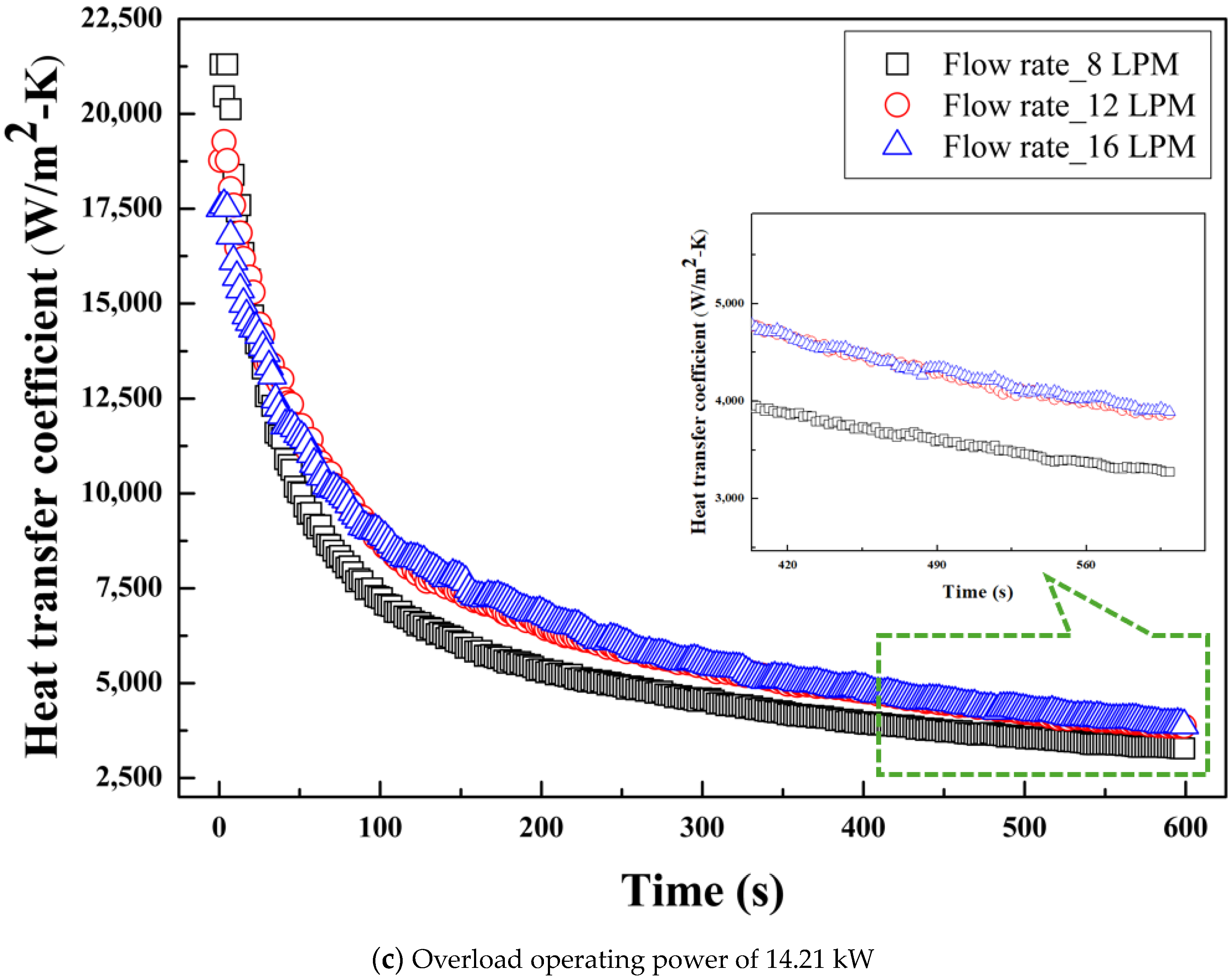

| Property | Value |
|---|---|
| Density (kg/m3) | 829.5 |
| Specific heat (J/kg-K) | 1978.7 |
| Viscosity (m2/s) | 10−5 |
| Thermal conductivity (W/m-K) | 0.136 |
Disclaimer/Publisher’s Note: The statements, opinions and data contained in all publications are solely those of the individual author(s) and contributor(s) and not of MDPI and/or the editor(s). MDPI and/or the editor(s) disclaim responsibility for any injury to people or property resulting from any ideas, methods, instructions or products referred to in the content. |
© 2024 by the authors. Licensee MDPI, Basel, Switzerland. This article is an open access article distributed under the terms and conditions of the Creative Commons Attribution (CC BY) license (https://creativecommons.org/licenses/by/4.0/).
Share and Cite
Kang, E.-H.; Garud, K.S.; Park, S.C.; Lee, M.-Y. Heat Transfer Characteristics of an Electric Motor with Oil-Dripping Cooling under Overload Conditions. Symmetry 2024, 16, 289. https://doi.org/10.3390/sym16030289
Kang E-H, Garud KS, Park SC, Lee M-Y. Heat Transfer Characteristics of an Electric Motor with Oil-Dripping Cooling under Overload Conditions. Symmetry. 2024; 16(3):289. https://doi.org/10.3390/sym16030289
Chicago/Turabian StyleKang, Eun-Hyeok, Kunal Sandip Garud, Su Cheong Park, and Moo-Yeon Lee. 2024. "Heat Transfer Characteristics of an Electric Motor with Oil-Dripping Cooling under Overload Conditions" Symmetry 16, no. 3: 289. https://doi.org/10.3390/sym16030289
APA StyleKang, E.-H., Garud, K. S., Park, S. C., & Lee, M.-Y. (2024). Heat Transfer Characteristics of an Electric Motor with Oil-Dripping Cooling under Overload Conditions. Symmetry, 16(3), 289. https://doi.org/10.3390/sym16030289







